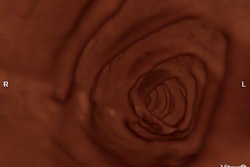SAN FRANCISCO - These days, it seems that just about everything is better with multislice CT. In orthopedic imaging, multislice CT is proving more effective than conventional radiography in finding lesions caused by osteolysis that result as a complication of total knee arthroscopy, according to a presentation Friday at the American Academy of Orthopaedic Surgeons (AAOS) meeting.
Osteolysis occurs in about 16% of cementless total knee arthroscopy (TKA) cases in which tibial fixation is achieved with bone screws, but it also occurs in cemented TKA, according to Dr. Timothy Reish of the Insall Scott Kelly Institute for Orthopaedics and Sports Medicine in New York City. Conventional x-ray has traditionally been used to diagnose osteolysis, but there are shortcomings to this modality -- it can minimize the degree of bone loss, lesions can be obscured by the prosthesis, and images must be taken in the proper plane for adequate visualization.
CT has historically been suboptimal for diagnosing TKA-related osteolysis, due to the artifacts caused by metal in the orthopedic hardware. Multislice scanning, however, is less affected by these artifacts, and appears to allow better delineation of osteolytic lesions. To assess the modality’s utility in this area, Reish’s group launched a study to determine the accuracy of multislice CT versus plain radiography.
The group retrospectively examined 31 patients, with an average age of 69, who presented with painful TKA in which infection had been ruled out with standard blood work and aspiration. Of the 31 patients, 25 had posterior-stabilized knees, six had cruciate-retaining knees, and all components were cemented on both sides. Patients received x-rays prior to CT and were sent on to CT regardless of x-ray findings.
Patients were scanned in the axial, coronal, and sagittal planes, and lesions were defined as sharply demarcated areas of lucency without osseous trabeculae. Osteopenia and linear radiolucencies at the bone/cement interface were not included in the study, Reish said. Studies were read by a fellowship-trained musculoskeletal radiologist.
Conventional radiography detected osteolytic lesions in 8/31 patients (26%). Four studies were read as loose without evidence of osteolysis, while three were read as stable lucency under the medial tibial plateau.
CT scanning, on the other hand, detected 48 lesions in 31 knees, 38 of which were tibial lesions, two were tibial stem lesions, four were patellar lesions, and four were femoral lesions. In addition to finding more lesions, CT found smaller ones as well: The average size of the lesions picked up by CT was 11.4 cm3, compared with an average size of 40.1 cm3 on x-ray. The average size of the 40 lesions seen on CT but missed by x-ray was 5.6 cm3.
Surgical intervention (revision) was required in 23 knees, eight of which required bone grafts. These tended to be larger lesions, with an average lesion size of 36.9 cm3. Of these eight lesions, seven were detected on x-ray.
Reish concluded by stating that MSCT was clearly superior to plain radiography in diagnosing osteolytis around TKA. "Once the lesion is detected on x-ray, it has already caused significant bony destruction," Reish said. "Multidetector CT can aid in the preoperative planning for revision of total knee with accurate assessment of uncontained defects, and plain x-ray is an inadequate means by which to diagnose osteolysis around total knee."
In the question-and-answer session, a session attendee asked if the group had reviewed the x-rays after the study to see if they could find the osteolytic lesions that had been missed. Reish said that they did for a number of studies, without much success. "It was very difficult to tell the location as well as the size of these lesions on x-ray," he said.
By Brian CaseyAuntMinnie.com staff writer
March 15, 2004
Related Reading
Tunnel-view x-ray holds the key to locked-knee syndrome, March 12, 2004
Just (over) Do It! Imaging pegs overuse injuries in specialty sports, October 10, 2003
MRI pinpoints meniscal tears, proves less valuable for knee trauma, January 9, 2003
Copyright © 2004 AuntMinnie.com




















